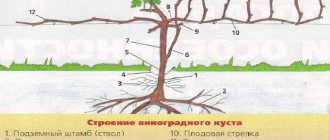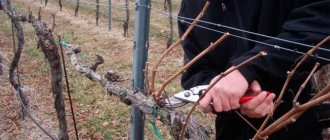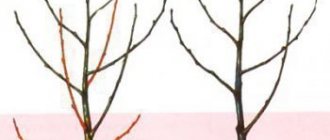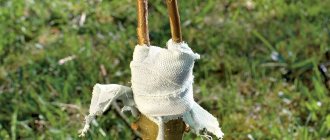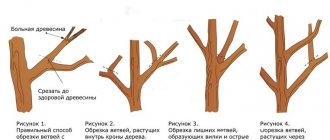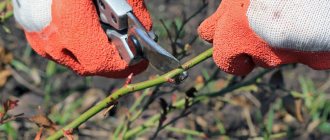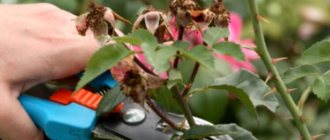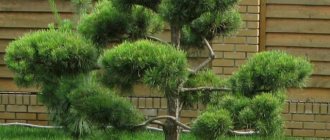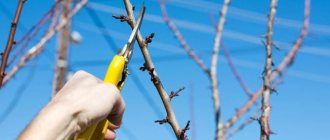Why is pruning necessary?
Many home garden owners consider pruning to be an optional activity. Citing their own trees as an example, they boast of stable growth and high yields. But without proper care, the crown quickly thickens, preventing light and air from reaching the central part of the tree.
Fruitful branches begin to quickly die, and the few remaining branches form several times fewer buds. Fruits set when there is insufficient lighting grow small and tasteless, and the lack of ventilation in the crown provokes the development of bacteria and wood rotting.
Timely pruning of cherries improves the condition of the tree and harmonizes its development:
- allows you to correctly form the crown;
- significantly increases productivity;
- develops resistance to temperature changes;
- reduces the risk of garden pest infestation.
It is known that the lateral horizontal branches have maximum fruitfulness. The pruning procedure directs the development of the seedling to the specified areas, allowing for a high yield.
Timing for pruning
The start of corrective work often coincides with the planting of the tree. This event is carried out in several stages, since removing a large number of branches in one season reduces the vital activity of the plant and reduces its yield. Let's consider the specific pruning time depending on the period of work.
Winter pruning period
Since during the cold season the wood becomes brittle and vulnerable to temperature changes, large-scale removal of branches is undesirable. The only acceptable measure is anti-aging pruning - a procedure carried out on large old trees whose yield is falling and the quality of the fruit is decreasing.
It is better to carry out work in February, monitoring the temperature forecast and choosing the warmest days.
Spring pruning time
Spring landscaping of the garden should be carried out before the buds swell and the sap begins to flow, from mid-March to the first week of April. During this period, plant branches are thinned out, which improves air supply to the crown and promotes uniform distribution of sunlight. The trees are carefully inspected, removing damaged branches and branches that were damaged by frost.
Summer pruning time
Summer pruning is carried out in two stages, between the end of flowering and the beginning of fruit appearance. They are carried out in early July, accompanied by shortening of young shoots and the formation of the basis of the future structure. The second time the cherries are pruned after harvesting.
Autumn pruning time
The signal for autumn pruning is the fall of leaves. The procedure is carried out until the end of September or the beginning of October so that the cuttings are better overgrown and the tree does not waste a lot of nutrients. Broken and unfruitful branches are also removed, the absence of which allows the cherry tree to better withstand the winter.
Importance of the procedure
Starting to understand the basic intricacies of autumn pruning of cherries, it is necessary to understand for what purposes such work is intended and why it is better to carry it out in the fall rather than in the spring. Many novice gardeners do not pay special attention to pruning activities, which negatively affects fruiting and crop growth productivity. In addition, without regular pruning, the cherry tree becomes overgrown, becomes dense and vulnerable to numerous diseases.
Every beginner should understand that a tree can bear fruit until its crown completely thickens. If this happens, you can’t even dream of a good harvest.
This kind of trouble can be explained very simply: the thickened crown does not allow light to pass through, and the branches begin to feel the lack of valuable light. And while young trees can cope with this phenomenon, older trees are susceptible to the death of fruit branches. Constant shadow reduces the number of flower buds and, accordingly, reduces the overall cherry yield. On such crops, ovaries are formed less and less often, and the quality of the fruit becomes extremely low. In addition, all kinds of diseases begin to develop in the thickened crown and insect pests appear.
The task and importance of regular pruning work is as follows::
- Increasing the yield of fruit crops.
- Significant improvement in the quality of berries, their taste and juiciness.
- Developing a good immune system that can resist many dangerous infections and diseases.
- Increased resistance to negative temperatures in winter.
- Extending the life of a culture.
Based on the fact that the pruning scheme directly depends on the task being monitored, before starting work, you need to decide why it is being performed.
You may be interested in:
Feeding fruit trees and shrubs in the fall Severe frosts can be dangerous for trees and shrubs planted with love. Because of this, gardeners and...Read more...
What tools are needed?
The main requirements for pruning equipment are strength and quality. Tools purchased from an unscrupulous seller will quickly become unusable and will not be able to perform their functions, which will affect the health of the tree and its productivity.
Sharp cutting tool for working with branches:
- Secateurs – used for cutting branches up to 2.5 cm thick.
- Lopper - similar to pruning shears, but has longer handles, which are convenient for working in hard-to-reach places or in neglected crowns. Copes well with thick branches from 3 cm.
- A garden saw is the main tool for processing old trees and sawing thick branches.
- Knife – used for cleaning cuts and performing procedures that require precision.
- Scissors - used for thinning seedlings and shoots that have not yet become woody.
Auxiliary equipment for gardening:
- Stepladder – necessary for pruning tall trees.
- Work gloves – provide protection for hands when performing activities.
- Safety glasses – prevent small debris falling from the tree when pruning from getting into your eyes.
- Rope - fixes bent branches in one position.
- Spacers are a simple device that bends branches away from the treated area.
- Cuffs are strips of elastic material that protect the bark of young branches from mechanical damage.
Cherry wood is softer and more fragile than that of other garden crops, so it is not advisable to trim the branches with simple pruning shears. To minimize damage to the shoots, it is better to use garden saws, carefully clearing the cut points with a knife.
Why do you need to prune cherry trees?
Many gardeners believe that it is better not to prune stone fruit trees, especially cherries and cherries, allowing the trees to grow naturally.
Cherry trees are pruned to increase productivity
Agreeing with this is not quite the right thing to do. Formative pruning of stone fruits allows you to improve the health of the tree crown (dried twigs and branches are cut out, which serve as additional gates for the penetration of harmful infections and pests into the wood). When pruning, removing branches growing inside the crown allows air to enter; this operation can significantly reduce the risk of developing pathological fungal infections.
When pruning, a strong skeleton of the tree is formed, the height of the trunk is reduced, which makes harvesting easier, and simplifies the work on treating the garden from pests.
Advice! A strong, healthy tree is the key to a bountiful harvest; regular pruning helps stimulate fruiting.
How to cut branches correctly?
Regardless of the time of sanitary work, there are general recommendations that must be followed:
- The pruning procedure begins with an inspection of the garden. This will help identify dimly lit and poorly ventilated places inside the crown, and eliminate diseased and undeveloped areas. If some branches cross, they are cut off, leaving a stronger one.
- It is necessary to cut cherry branches at the base, in the middle of the annular influx. In this place there are tissues that accelerate the overgrowth of wood. If you make cut after cut, the wound will be too large, and the plant will take a long time to recover.
- Also, stumps should not be left on the main trunk and side branches - over time they will rot and the tree may die completely. If the branch is thick and heavy, it can be cut in two stages, sawing off the main part of the wood and removing the remaining stump.
- Be sure to disinfect the sections. When removing small branches up to 1 cm thick, the surface is treated with garden varnish or natural oil paint. Larger sections are coated with mullein and clay, and then covered with film.
If the procedure is carried out in the spring season, you need to beware of cold and dampness. Overcooling during the pruning stage can cause gum to appear on the branches and trunk, which is harmful to all stone fruits.
Features of pruning cherries
The full range of pruning measures depends on the region in which the crops are planted, its climate regime and the age of the tree itself. To form a healthy plant that will actively bear fruit, have an aesthetic appearance and ensure ease of collection, work must be carried out regularly from the first year of planting.
Spring pruning
During this period, different types of pruning are carried out, it all depends on the age of the cherry tree.
Saplings. When applied to seedlings at an early stage of development, the procedure lays the foundation for the development of the crown and gives it a stable shape. Usually correction is carried out when the seedling reaches a height of 70 cm or more. If the cherries were planted in the fall, the shoots are pruned no earlier than after a year and a half. Unlike mature trees, part of the top of the seedling is removed in the first spring. The required distance is calculated by counting 6 young buds from the main shoot.
The tree is 2 years old. In spring, two-year-old cherries form the lower tier of branches. To correct this area, you need to select 4 strong shoots. Using a pruner or lopper, each branch is shortened by 40-50 cm. A similar procedure is carried out with a central conductor, from which the 4 upper buds are counted and the top is removed.
Third year. A tree that has reached its third spring forms a crown on two tiers. To control this process, skeletal shoots are shortened, comparing the length with the smallest branch. Young shoots directed into the depths of the crown are cut off completely. If the remaining branches are directed upward and sideways, forming an angle of no more than 45 degrees with the central trunk, the crown is formed correctly.
Fourth year . During the fourth spring pruning, the trunk is brought to the level of young skeletal branches located on the side of the crown. The third tier is adjusted 20 cm below the top, but not longer than 70 cm. If the branches of the second tier do not exceed this length, shortening is not required. All the following operations carried out in the spring season will include the removal of branches growing deep into the crown or straight up.
Watch a video about pruning cherries in spring:
Summer pruning
Timely summer pruning is a good way to limit the growth of annual growth that is of no value to the gardener. The crown, thinned this season, is open to the favorable influences of the environment, which directly improves the taste and quality of the growing fruits. Technically, the procedure resembles spring pruning of an adult tree, but due to active growth it is faster and with less damage.
Summer corrective work is carried out at the end of May. In this case, the gardener removes defective branches and part of the central conductor, removing the trunk at a height of 3.5 m and transferring growth to a strong lateral shoot. The current year's shoots are shortened by 4-5 leaves to a total length of 15-20 cm. This procedure stimulates branching and the formation of ovaries. If the deadline for corrective work is missed, carry it out after harvesting.
At the end of the fruiting season, the cut branches grow again. They need to be shortened to 10 cm, leaving 3-4 leaves on which new flower buds will form next year. In addition to making the tree healthier, this will help get rid of pest colonies, protect skeletal branches from exposure and reduce labor costs.
Pruning after planting
The optimal time for pruning a seedling coincides with the moment of its planting. Removing excess branches at this stage gives the crown the required shape, speeds up the establishment of the root system in the new soil and improves the distribution of nutrients among the remaining shoots.
The procedure is performed before the formation of kidneys begins. The gardener selects 4-5 of the strongest branches, cuts off the rest and carefully covers the wounds. The remaining shoots should be directed to the sides and located 10 cm from each other. Further work is carried out on seedlings that are well rooted and have lived on the site for more than a year.
If you are interested in how to plant cherries correctly, you can read this article. It describes in detail the method of planting cherries in the spring and further caring for the tree.
Work on an old tree
Mature cherry trees produce a good harvest and have a well-formed crown, but they need sanitary work no less than young seedlings. Every year, frozen shoots appear on the trunk, the bark in some areas peels off and is affected by diseases, and the branches are subject to mechanical damage and stop bearing fruit. Pruning an old tree helps rejuvenate the plant and is done in dry, warm weather.
When inspecting the trunk, all growths that have appeared over the last 3-4 years are removed, broken branches and other defective areas are removed. Similar to other types of pruning, the cut areas are lubricated with garden varnish, and if the wound is too large, they are wrapped with film. If the correction was carried out correctly, during the season the tree will produce many young shoots, and the number of fruits will increase significantly.
Pruning a young tree
The current type of pruning of young seedlings is shortening the annual growth. There are three types of this procedure: weak, medium and strong shortening. The specific type of event is determined based on the growth characteristics of other trees on the site, the composition of the soil and the established climate in the place of work:
- With weak shortening, the young seedling is cut to a quarter of its length, stimulating the growth of the upper buds and the elongation of shoots at an acute angle.
- Medium shortening involves pruning half the plant: the seedling forms more side shoots and begins to bear fruit earlier, but skeletal branches form more slowly.
- The severe shortening option involves removing more than half of the seedling. On the remaining buds, strong lateral shoots appear, running parallel to the trunk or with a slight deviation.
The process of pruning a young tree can be seen in the video below:
Basic stages
Residents of the Moscow region and mid-latitudes of the Russian Federation begin autumn pruning of cherries from the moment the leaves fall until the end of September. During this work, all weak and damaged branches are removed, since a thoroughly cleaned tree is characterized by higher resistance to winter cold.
Also in the fall, intensive crown thinning is carried out, which consists of removing all branches growing at the wrong angle. Another autumn procedure can monitor the goal of shortening too long bends by a third of their length. To successfully prune cherries in the fall, you should use special gardening tools. It consists of:
- Garden saw with sharp sharpening.
- Secateurs.
- Garden var.
If for some reason the tree begins to stretch upward (this can be caused by overgrowing of the crown and lack of lighting), which complicates the harvesting process, the gardener can use a special type of pruning. It consists in forming a bowl-shaped crown and reducing the height of the tree.
Important!
At the beginning of the corrective work, you need to get rid of strongly raised branches. This approach will become a natural stimulation for the development of external shoots, which are much weaker than the previous ones.
By removing the top branches, you can reduce the height of the tree, as well as increase its width. As soon as the formed wounds heal, the crop will begin intensive growth and increase in green mass. Soon flower buds and fruits will begin to appear on the new branches. And where there were recently cuts, only minor bends will soon remain.
Next, the agronomist will need to promptly get rid of shoots directed inward, preventing the crown from re-thickening. Otherwise, the efforts spent may be useless.
Cherry formation
The purpose of cherry formation is to keep the tree within certain boundaries, control its growth and fruit formation. The procedures carried out at different periods of seedling development differ in execution, but they are based on the general principle of increasing productivity.
In the first year
For cherries, a sparsely layered crown is best suited. It includes a thick trunk 3-4 m high and a number of skeletal branches extending from the central conductor at an angle of 40-50 degrees. To lay the foundations of such a structure, annual growths are shortened from a third to a half, removing unripe parts and frozen shoots. Work is carried out in early spring until buds form.
In the second year
The main stage of corrective work takes place in the second year, when the seedling has successfully acclimatized at the planting site. The first tier of the crown is made up of young shoots growing half a meter from the ground. The gardener selects the 3 most powerful branches, located at a distance of 15-20 cm from each other, and completely cuts off the remaining shoots.
Next years
In the third year, the cherry seedling grows strongly, so you can begin to form the second tier. When starting pruning, move half a meter up from the first layer of branches and select 2 strong shoots. In a similar way, a third tier is formed, 30-40 cm distant from the second. One skeletal branch is left in it and the central conductor, which rises above it, is cut off.
After processing the base of the crown, it is necessary to form the side conductors. To do this, several first-order shoots are selected on the skeletal branches. When the selected branches reach 70 cm, they are shortened. If the shoots are involved in creating the frame, they are pruned to 50 cm, otherwise to 20 cm. The crown of the cherry tree takes on its final shape at 5-6 years, after which sanitary and anti-aging pruning is carried out.
Advice from experienced gardeners
Gardeners with extensive experience in growing and pruning cherry fruit trees warn beginners against the following mistakes:
- Many do not completely shorten the tops of the seedlings, leaving a length of more than 1 m. Due to such actions, fruiting will be located no lower than 2 m from the ground.
- Inexperienced gardeners rush to plant the second and third tiers, which leads to weakening and dying of the branches of the first tier. The result of this is the movement of the crown upward and a significant reduction in the amount of harvest.
- Often, pruning of cherries is carried out according to the principle of forming apple or pear trees. The consequence of this is shoots that are of insufficient length, as well as a significant acceleration of general growth processes.
- Many gardeners do not prune thick, long shoots enough (less than half), which leads to delayed fruiting.
Did you know? Cherries can be used as food coloring. However, contrary to expectations, the color will be green, not red.
At first glance, pruning may seem quite labor-intensive and tedious to an inexperienced gardener. However, having gradually understood all aspects of this procedure, it is easy to understand the basic principles of the formation of the crown of cherry trees. As a reward, you can get not only a beautiful garden, but also a constant and abundant harvest.
Basic crown forms
A sparsely tiered crown is not the only type of arrangement of branches in a growing seedling. In foreign horticulture, crowns can be given other forms, ensuring high yields and guaranteed stability of fruit formation.
When starting corrective work, make a pruning plan in advance. If the frame branches have already formed, it will be impossible to change the structure of the tree.
"Spanish Bush"
The method of correcting fruit crops, adopted on the Iberian Peninsula, not only restrains the growth of trees, but also compacts plantings, improving the ripening of fruits and simplifying their collection. It is well suited for regions with a mild climate and the absence of strong temperature changes.
How to do the shaping:
- The formation of the “Spanish bush” begins in the spring, if more than a year has passed since the seedling was planted in a new area. After making sure that the plant has gained sufficient height, it is shortened to 40-70 cm. The specific value depends on the number of buds on the trunk and the planned location of the shoots that form the base of the crown.
- During the summer, the buds remaining on the trunk form branches 50-60 cm long. It is necessary to select the 4 strongest shoots and shorten them, leaving the tops 10-15 cm above the main trunk. To adjust the angle of inclination, the branches are tied to pegs.
- In autumn, trellises are built on the site where young trees are grown. One-year-old half-meter shoots must be tied to them. This procedure allows you to form a symmetrical open crown, improve access of sunlight to the fruits and accelerate the formation of ovaries.
- A year after corrective measures, the branches are pruned again. Shoots tied to trellises and annual shoots on the sides of the trunk are shortened to a quarter of a meter. Branches located in the center of the crown or growing parallel to the ground are left untouched.
Proper execution of the work will contribute to the branching of shortened shoots and the formation of the first harvest in untouched areas.
In this video, the gardener shares his experience in forming cherries according to the “Spanish bush” type. This type is considered the most popular, so we decided to show it:
"Australian bush"
The Australian pruning method involves creating a low crown for easier harvesting. The branch structure is strengthened by the presence of several trunks of the same size.
Formation of cherries:
- Immediately after landing. Cherries are cut to half a meter. During the summer season, side shoots appear on the trunk, of which 4 are selected. Branches that are not suitable in strength and length are removed. After the shoot reaches a length of 4-6 cm above its growth point, attach a clothespin, placing it parallel to the trunk. This corrects the direction of the branches, making them almost horizontal.
- In the spring of the second year. The tree is inspected again, removing all shoots that escape from the crown structure. If the shoot is skeletal, gentle first-order branches are left on it, which gives the cherry the shape of a fruit vase.
- In the third year. The crown of the cherry tree is cleared of young shoots, cutting it to a length of 8-10 cm. If this is not done, the main bouquet branches will be shaded and the yield will decrease.
Further work will include autumn pruning of annual growth, sanitary removal of shading branches, pest and frost control, as well as crown adjustment within the existing shape.
Forming KGB cherries
Kym Green Bush is a modern forming scheme that ensures compact planting, promotes tree rejuvenation and reduces the risk of winter freezing. The KGB system resembles the “Spanish bush”, but differs from it in the placement of fruiting areas.
It is known that in fruit crops pruned according to the Spanish system, vertical leaders are permanent, and the formation of ovaries proceeds to renewable shoots and lateral branches. In the KGB system, on the contrary, the development of lateral branches is canceled, and fruit growth takes place on renewable vertical leaders.
Regardless of the age of the tree, the shape of the crown and the characteristics of its growth, the pruning procedure stimulates its development, increases the yield and protects it from aggressive environmental influences. The nuances of this procedure described in the article will be useful to both novice gardeners and experts in the field of agriculture.
0
0
Copy link
